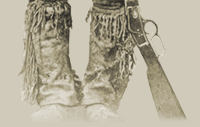|

[ Project Plans | Essential
Questions | Knowledge Hunt | Glossary | Links ]
Is History Carved in Stone?
Creating the Headstone of a Historical Figure to Understand Their
Character and Achievements
Introduction
Students need to critically examine the ways of life of British
and European immigrants by exploring and reflecting on what their
stories tell us about their presence in Canada. Not all of the Mavericks
were saintly and they may be judged differently as time goes on.
How were these people viewed when they passed away? How do we view
them now?
Project Explanation
In this project, students will develop an appreciation of the accomplishments
of the "Uninvited Guest" Mavericks and how European
immigrants shaped ways of life in Western Canada. They will research
and write an epitaph for a Maverick and then plan and create a headstone
to remember them by.
Alberta Social Studies Curriculum Unit Connections
Grade Four - Alberta: The Land, Histories and Stories
4.2 The Stories, Histories and People of Alberta
4.3 Alberta: Celebrations and Challenges
Grade Five - Canada: The Land, Histories and Stories
5.2 Histories and Stories of Ways of Life in Canada
5.3 Canada: Shaping an Identify
Grade Seven - Canada: Origins, Histories and Movement of People
7.1 Toward Confederation
7.2 Following Confederation: Canadian Expansions
Materials and Resources Needed
Procedures
Students will research and create a headstone for one of the "Uninvited
Guest" Mavericks from the Mavericks: An Incorrigible History
of Alberta site. Teachers may introduce the project by asking
students about cemeteries and their purpose.
- What is a cemetery?
- Why do we have cemeteries?
- What is the purpose of a gravestone?
- What is an epitaph?
The websites listed above can be used to show students some examples
of tombstones and epitaphs that have been used for real markers.
When examining the headstones, have the students infer what we can
learn about the person from observing the epitaph (written inscription),
the size and shape, and any carvings or symbols.
Students will then choose and research a Maverick to create a headstone
for using the Mavericks: An Incorrigible History of Alberta
site. They should write a short personal history of the Maverick
they chose, including key events and accomplishments. They will
then write up an historically accurate epitaph, including any pertinent
information like year of birth, year of death, great accomplishments
or failures, proud moments, quotes, poems, etc. They can decide
if they want to have symbols or decoration indicative of the Maverick's
life on the headstone, and use the sites above to find out their
meaning. They can also look at different fonts and choose the style
of text they would like to have.
Once the epitaph is written and planned, students will sketch the
headstone and label the size, including length, width, and height.
They will need to make sure at this point that the headstone truly
portrays the image and personality they would like it to depict.
Once a full drawing has been created, students could make a three-dimensional
representation using clay or papier-mâché. When finished,
the models (or the 2-d sketches) may be displayed along with the
Maverick's personal history.
Assessment and Evaluation
- Students and their teacher should develop their own rubric by
identifying evaluation criteria for the project that will match
their own learner outcomes. This allows students to understand
the expectations for their work and to have input into the ongoing
evaluation process.
- Students may evaluate themselves and their peers using their
project rubric, examining each other's project for historical
accuracy, detail, and creativity.
- A project journal may be used for information gathering as well
as for reflective writing as the process is taking place. Students
can pose questions, vent frustrations, synthesize their work,
examine their process, and even wonder about what they are missing
or what is still needed for their project. This may be completed
as a group or individually.
Ideas for Enriching this Project
- Students may examine their finished headstones using mathematical
measurement. The area and volume of the headstone could be calculated.
They could even find out the costs for certain types of stone
and calculate how much their headstone would cost to have made.
- Students could examine changes to burial practices such as headstones
throughout time. How have these changed?
- Students could examine how burial practices are different among
distinct cultures. For example, how did First Nations people deal
with their dead?
 |



![]()
